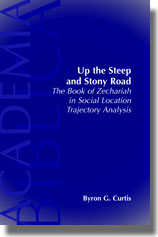
$47.00
How do we account for the strange fourteen-chaptered form of the book of Zechariah? What is the social and historical matrix from which this book derives? Marshaling data about the social typology of religious movements led by such twentieth-century African prophets as Alice Lenshina, Isaiah Shembe, and Simon Kimbangu, Curtis constructs a new method of reading prophetic books, a method he calls “social location trajectory analysis,” and applies this method to interpret the book of Zechariah in a new light. The author suggests that Zechariah was a product of a single generation in the early Persian period and reopens the possibility that it might, after all, have but one principal author, the eponymous prophet whose name is borne by all fourteen chapters.
Byron G. Curtis is Associate Professor of Biblical Studies at Geneva College, Beaver Falls, Pennsylvania. He has a Ph.D. from Westminster Theological Seminary and is an ordained minister in the Presbyterian Church in America.
“[Curtis’s] use of social location trajectory analysis makes a strong case against the necessity of dividing between Zechariah 1–8 and 9–14. As C. is aware, this analysis cannot prove common authorship. Nonetheless, his book reopens the discussion and might force those in favour of multiple authors to reconsider their arguments.”
— L.-S. Tiemeyer, Journal for the Study of the Old Testament
